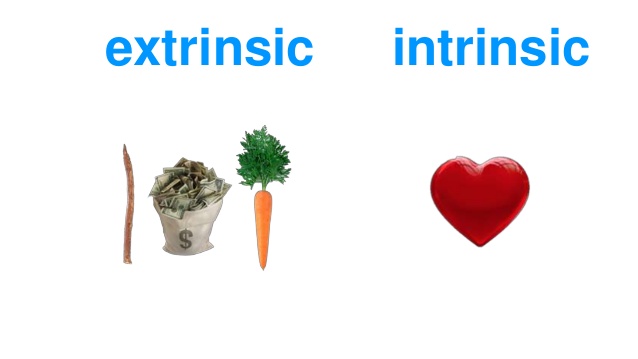I have heard many people talk about intrinsic motivation and how we need to get more of it – especially in schools. But what exactly is intrinsic motivation and why should we nurture it? This is a 2-part blog post. In part 1 (this one) I explore what intrinsic motivation is and why it matters. In part two (follow the blog to get informed when it’s online) I will explore how intrinsic motivation can be implemented in the classroom.

Psychologists usually distinguish between two types of motivation – extrinsic and intrinsic motivation. Extrinsic motivation is when you engage in an activity in order to reach a certain goal. For example, practicing for a recital or working hard for a promotion or studying for good grades. Compare that to intrinsic motivation where you engage in an activity for the sake of the activity. For example, dancing, singing, playing an instrument or a computer game.

Wait, why am I doing this?
As a teacher I wonder about how external motivators such as grades or behaviour points affect the intrinsic motivation of my students to learn. I want my students to develop a positive attitude towards learning and continue to learn even after having left school. However, many of my students engage with learning because of such external motivators. It is only logical to conclude that at least some of these students may stop pursuing knowledge once these external motivators are no longer present. I often hear sentences like “Sir, is this enough for a ‘good work’ point?” or “Sir, can you call my parents and let them know that I did well today?”How can I inspire children if their attention is not directed towards the content of the lesson, but rather on the reward that comes with it?
We want our children to find things in life such as a career or a hobby that they will enjoy. But by linking a joyful activity to an extrinsic motivator they may miss the joy that lies within the activity. They may one day find themselves – like so many of us – wondering why they are doing what they are doing and having trouble identifying their true passions.
A joyful activity may become a means to an end rather than an end in itself.
But is all of this actually true? Can extrinsic motivators decrease intrinsic motivation?

This question was first addressed in 1973 (Source). Researchers gave 3-5 year olds a set of brand new magic markers. After having drawn with them for some time they split the children into three groups. The reward group was promised a gold star if they drew with the magic markers for 6 minutes. The surprise reward group received the gold star after 6 minutes completely unexpected. Finally, the no reward group received no reward.
A few weeks after the experiment the researchers went back to check how much children were using the markers. Surprisingly, children from the reward group were using the markers half as much as children from the surprise reward and the no reward group. The gold star had significantly affected how much these children enjoy drawing – in the long run. It is as if they had forgotten why they were drawing in the first place.
 A more powerful illustration of how rewards can have a negative impact on intrinsic motivation came in 1976. Students were presented with 7 puzzles, which were ranked in order of difficulty. Some of the students were told that they would get a reward upon solving a puzzle (reward group) and some weren’t promised anything (no reward group). The results showed that students from the reward group chose significantly less difficult puzzles compared to the students from the no reward group (Source). If we take puzzle-solving as an analogy for all the challenges we encounter in our lives it becomes blatantly obvious how easy external motivators can hijack intrinsic motivation. We stop seeing puzzles as what they are – a fun activity – and gaze over to see the reward. Solving the puzzle has stopped being the source of joy. Instead, the new source of joy is now the reward. The puzzle is now only a means to an end. Finally, think about the quality of a child’s work if they are seeing the activity only as an intermediate step? How much better would their work be if they would pour their hearts into it?
A more powerful illustration of how rewards can have a negative impact on intrinsic motivation came in 1976. Students were presented with 7 puzzles, which were ranked in order of difficulty. Some of the students were told that they would get a reward upon solving a puzzle (reward group) and some weren’t promised anything (no reward group). The results showed that students from the reward group chose significantly less difficult puzzles compared to the students from the no reward group (Source). If we take puzzle-solving as an analogy for all the challenges we encounter in our lives it becomes blatantly obvious how easy external motivators can hijack intrinsic motivation. We stop seeing puzzles as what they are – a fun activity – and gaze over to see the reward. Solving the puzzle has stopped being the source of joy. Instead, the new source of joy is now the reward. The puzzle is now only a means to an end. Finally, think about the quality of a child’s work if they are seeing the activity only as an intermediate step? How much better would their work be if they would pour their hearts into it?
Countless studies over the decades have linked intrinsic motivation to a range of positive outcomes such as more creative work (Source), more pro-social behaviour (Source), better long-term retention of information (Source) and better problem-solving skills (Source). But even more importantly, people report higher levels of psychological well-being when engaging in intrinsically rewarding activities (Source). If children are supposed to become the passion-driven leaders we want them to be we might want to think about how we can foster their intrinsic motivation.

That is all good and well, but how exactly can I as a teacher foster intrinsic motivation in my students?
Part 2 of this blog with take a look at concrete ways of how intrinsic motivation can be implemented in the classroom. These findings can also be applied to one’s personal life. Follow this blog to get an update as soon as part 2 is out.

Awesome! Its in fact awesome post, I have got much clear idea on the topic of from this piece of writing
LikeLiked by 1 person